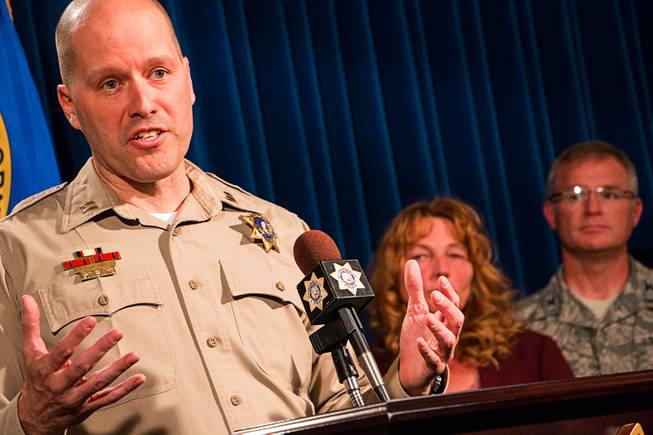
Metro Police Capt. James LaRochelle, left, on Thursday, Nov. 16, 2017, presents the ShotSpotter technology that has been implemented in the Las Vegas Valley as part of a one-year pilot program that uses sensors to triangulate the source of gunfire. At right are Clark County Commissioner Marilyn Kirkpatrick and Nellis Air Force Base Commander Col. Paul Murray.
Friday, Nov. 17, 2017 | 2 a.m.
A blast goes off in the middle of a crime-ridden neighborhood, and by the time someone deems it a possible gunshot and calls 911, valuable investigative time and the likelihood of catching the shooter diminish.
And if multiple callers aren’t reporting the same sound — which can often be fireworks or a car backfiring — and there is no visual of a victim or suspect, it can take officers even longer to respond, Metro Police Capt. James LaRochelle said Thursday.
The ShotSpotter system aims to improve police response by cutting officer arrival times, while making sure they're dispatched to the exact source of gunfire, according to the company.
Metro, in collaboration with Clark County officials, on Thursday launched a one-year ShotSpotter pilot program in the northeast valley, without elaborating which area is covered, LaRochelle said. Its $500,000 cost is being funded through grants.
Implementations in other high-gun-violence areas in the south and southeast valley are being processed, LaRochelle said. And if the program is productive after its trial, it may be expanded to other areas, which could include the Las Vegas Strip corridor and downtown.
The technology features a series of sensors placed on buildings and utility posts that can detect gunshot-like sounds, the company said.
When the sound goes off in the covered area, sound experts with the company are notified. In no more than 45 seconds, they determine if the sound is in fact a gunshot and, if it is, immediately alert police.
Police, dispatchers, officers and detectives on work desktops receive the information and launch their protocol-established course of action, LaRochelle said. Police supervisors are required to respond to try to slow the momentum and ensure the safety of their rank and file.
Footage from cameras purchased from ShotSpotter will be monitored by officers in the Southern Nevada Counter Terrorism Center, LaRochelle said.
Metro investigative arms will be able to canvass the area faster, locate evidence and possibly additional witnesses, while trying to ease the level of fear in the neighborhoods, LaRochelle said.
LaRochelle said it would be "difficult to speculate" if the system may have been useful on the Strip during the Oct. 1 shooting, which he described as having "chaotic circumstances."
Use of the technology has been in discussions and negotiations for several months, and the mass killing did not sway the decision to implement it, LaRochelle said.
ShotSpotter has been deployed in about 90 cities across the U.S., including New York, Chicago and St. Louis, according to the company. Officials tout a reduction of violent crime in those neighborhoods that have adapted the technology.
The sensors only pick up sounds of a certain decibel level, and officers and analysts are not able to monitor other sounds, such as conversations, LaRochelle said. Metro representatives have had conversations with hundreds of community members and the feedback has been positive, he added.
Studies at UNR will look into the social impact of the program, while the law enforcement impact will be evaluated at UNLV, said Clark County Commissioner Marilyn Kirkpatrick, who has championed the program.
Officials warned that ShotSpotter does not replace the need for civilian collaboration. “We as a community cannot be apathetic to gun violence; we need help from the citizens living within these communities,” LaRochelle said.

